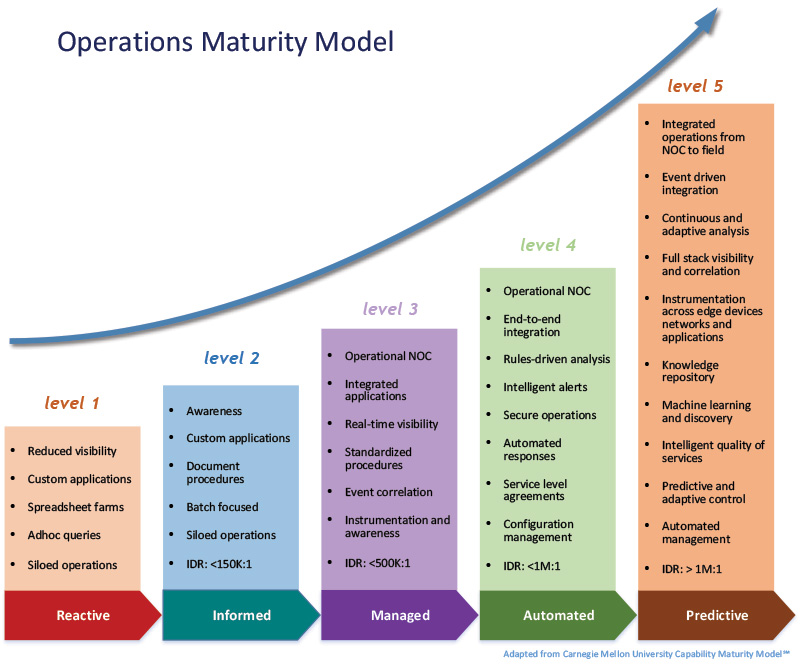As a longtime utility ‘insider,' I know first-hand the trials and tribulations of deploying and managing a smart grid. Now, with the added perspective of being a technology provider to the industry, I can share my experiences and lessons learned.
A utility with two million smart meters in the field is inundated with approximately 750 million data elements each day – that’s almost twice as many data elements as there are tweets floating around the global Twittersphere on a daily basis.
So it’s inevitable for a utility with a newly deployed smart grid to feel like it’s drowning in data.
The key to that utility’s ultimate success is its capacity to manage the influx of data at scale. More specifically, we can refer to this as its ‘operations maturity,’ or the utility’s ability to efficiently and effectively interpret the mass amounts of data it receives, in order to identify and manage the underlying issues communicated by that data, and to do it all cost effectively.
The Operations Maturity Model
To evaluate a utility’s operational maturity, we can see how it places on the Operations Maturity Model (see sidebar), which I’ve adapted from Carnegie Mellon University’s Capability Maturity Model to fit the utility industry. Ranking a utility on a scale from Level 1 to Level 5, the model measures a utility’s maturity in terms of how effective and efficient its operations are. A utility that has just begun the modernization process has operations that are reactive and ad hoc; a mature utility’s operations are adaptive and predictive.
Information-to-data ratio
A strong indicator of a utility’s operations maturity level is its information-to-data ratio (IDR), or the ratio of actionable information that a human operator needs to deal with compared with the amount of ‘noise’ or data elements that can be ignored. If a utility at Level 2 on the maturity scale has an IDR of 150,000:1, and deals with 750 million data elements a day, that’s 5,000 information events that need a human eye. If an operator can deal with a maximum of 100 events a day, the utility would need 50 operators on staff to handle the data load. However, if that utility takes the steps to mature to Level 3, it might raise its IDR to 500,000:1. It now only needs 15 operators to deal with a total of 1,500 events a day – a cost savings that speaks for itself. IDR is analogous to the signal-to-noise ratio (SNR) used in science and engineering, where it is used to measure the strength of the signal against that of the noise.
At this point in our industry’s modernization, many utilities are at Level 2, moving toward Level 3. A utility can move up the maturity scale by implementing plans that focus on one or more of three areas: people, processes and technology.
Make the most of your people
A newly deployed utility might still have separate departments managing IT (application) issues, OT (device) issues and telecom (network) issues. But a smart grid system involves a lot of overlap between these areas, so if you’re aiming for an efficiently integrated system, siloed operations won’t help you get there. In my experience, a matrixed structure knitting these three departments together works best. All queries are funneled to one point of contact who acts as an internal service provider. That person then triages the issues and sources the right expertise to deal with them. The key here is to focus on business outcomes and not the traditional roles and responsibilities of your team.
Streamline your processes
When a utility deploys its smart grid, it will naturally have basic steps it follows to handle data events that arise. In the beginning, these may be ad hoc procedures, but as the utility matures, these procedures will be replaced by more comprehensive and adaptable processes. These processes should be logically structured and well documented, and it’s generally easiest to build them on an established framework such as ITIL or FCAPS. Because smart grids involve a lot of integration and overlap between departments, it’s key that the documented processes span the various domains involved and identify not only what needs to be done, but who is responsible for doing it.
Integrate your technologies
Field devices deliver an endless supply of data. But while spreadsheets and databases may be useful for storing that data, it takes time to input and it’s a strategy that doesn’t scale well – a 50,000-row spreadsheet is just unwieldy! Moreover, data warehouses don’t actively analyze the data for actionable insights without an operator manually running the reports. And most importantly, spreadsheets and databases don’t offer a real-time view of network operations, which is one of the primary strengths that a smart grid offers.
To get that real-time view, a utility needs to leverage a software application that easily integrates with its asset, work order, customer, GIS, telecom management and other systems. And the more integrated your technology platform is across your systems, the greater your visibility or ‘contextual view’ of your operations. The application can synthesize the data it’s receiving in real time, and output it instantaneously in charts, graphs, grids and interactive maps that make it easy to act on relevant insights.
The Operations Maturity Model
Level 1: Reactive
A utility at Level 1 is drowning in data. It may have spreadsheet farms and multiple databases to house it all, but without a tool to translate that data into useful information, the utility doesn’t have much visibility into how well it’s functioning. Operations are generally siloed, with separate groups managing the network, the software and the devices in the field, and their operational processes are largely ad hoc.
Level 2: Informed
As a utility builds custom applications to translate its data into usable information, it has greater visibility into its operations. However, as long as it has to actively run reports to get a snapshot of what’s going on, it’s not making use of the real-time capabilities of a smart grid network.
Level 3: Managed
At this stage, a utility has a functioning network operations center (NOC). Integrated applications correlate events happening on separate systems and provide a real-time view of what’s happening on the grid, allowing the utility to develop standard procedures to handle the situations it’s observing.
Level 4: Automated
By Level 4, the utility is relying on its software tool to do the vast majority of grid management behind the scenes. With the software using rule-based analysis of events and responding automatically to certain triggers, NOC staff receive more intelligent, high-level alerts and have significantly greater visibility into operations.
Level 5: Predictive
At this point, the utility is operating at peak efficiency; day-to-day grid management is fully automated and minimal staff are necessary for responding to only high-value alarms. The software is essentially a virtual operator and there’s an element of ‘machine learning and discovery,’ meaning the application can not only automatically respond to events, but discern and respond to patterns of events happening on the network.
What does operations maturity look like?
Without integrated software, a utility has limited visibility into its operations. If a smart meter in the field sends a tamper event or power outage notification, an operator has to take the time to find out why. Was someone tampering with the meter? Is there a problem with the communication network? But if the utility’s technology platform is integrated with the work order system, it can see that the tamper alert coincides with a work order to replace that meter – and it will know to ignore the alert.
This is rule-based analysis at the most basic level. The more comprehensive the contextual view of operations, the more complex that rule-based analysis becomes. Once fully integrated across a utility’s systems, the right technology will be capable of “predictive operations” – recognizing both events and data patterns happening in the field, and then automatically applying business rules to act accordingly.
The more business rules a utility ‘teaches’ its technology platform, the more sophisticated the virtual operator becomes. It learns to deal with the vast majority of events, data patterns and alarms, and flags only high-value issues for human operator analysis – resulting in a high IDR for the utility. Thus, predictive operations allow a utility to be effective, in that operators are freed up to deal with high-value issues as they arise, and efficient, because it can operate effectively with the minimum head count possible.
The benefits of maturity
In addition to a Network Operations Center (NOC) operating at peak efficiency, operations maturity brings added value to the whole business – including optimized operations, maintenance and administration expenditures in supporting the modernized grid. It’s also faster to pinpoint and resolve outages, which leads to better customer service and improved CAIDI/SAIDI ratings. A contextual view of operations also results in greater overall system security and helps to identify non-technical losses such as theft. Not to mention the peace of mind that comes from knowing that with a sophisticated virtual operator, someone’s always watching your grid.
Your growth plan
Whether you’ve already deployed your smart grid or are still in the planning stages, take time to consider where on the operations maturity scale your utility falls now. And more importantly, where do you want to be? Depending on the size of your grid and its complexity, you may not need to get all the way to Level 5 to meet your revenue or performance targets.
Next, look at where your greatest weaknesses and opportunities lie, and make a plan to address them. Do you need to restructure your technology support department? Formalize your operating processes? Source an integrated technology platform?
Finally, whatever your next steps, remember that maturing is a process and there will be growing pains along the way – but with a strong focus and commitment to the overall goal, you’ll get there!
About the Author
 As chief technology officer for Bit Stew Systems, Kai Hui works to keep Bit Stew’s world-leading Grid Director™ platform at the forefront of smart grid technology standards and real-time network operations. His experience as director of technology for the smart metering and infrastructure program at BC Hydro, British Columbia’s largest electric utility, informs his current role as a technology vendor.
As chief technology officer for Bit Stew Systems, Kai Hui works to keep Bit Stew’s world-leading Grid Director™ platform at the forefront of smart grid technology standards and real-time network operations. His experience as director of technology for the smart metering and infrastructure program at BC Hydro, British Columbia’s largest electric utility, informs his current role as a technology vendor.








